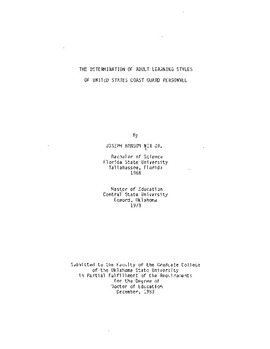| dc.contributor.advisor | James, Waynne B. | |
| dc.contributor.author | Nix, Joseph Hanson, Jr. | |
| dc.date.accessioned | 2015-10-05T16:08:43Z | |
| dc.date.available | 2015-10-05T16:08:43Z | |
| dc.date.issued | 1983-12 | |
| dc.identifier.uri | https://hdl.handle.net/11244/19408 | |
| dc.description.abstract | Scope of Study: The purpose of the study was to measure learning styles of U.S. Coast Guard Institute Personnel. Instruments used to conduct this measure were the Multi-Modal Paired Associates Learning Test II (MMPALT II) and the Perceptual Modality Preference Survey (PMPS). The population of this study was limited to 45 volunteers assigned to the U.S. Coast Guard Institute. Measurements were conducted between June 1 and October 6, 1983. Answers to five specific questions were sought in this study: What are the preferred learning styles of this population? Do subjects exhibit any perceptual learning style characteristics or patterns of characteristics in common with each other? Do self-assessed learning styles show positive correlation with actual measurements of the same style? Are there significant differences between officers, enlisted and civilian personnel? and are there significant differences between sex, education or age? Score, ranks and means were figured for each style on each instrument. Analysis of variance and a t test were used to test significance. Correlation coefficients were computed by the Pearson r method. | |
| dc.description.abstract | Findings and Conclusions: An examination of the scores obtained on the MMPALT II and PMPS by the subjects of this study revealed that no two subjects had identical scores or rank-order patterns. Similar result on previous studies led to the conclusion that the seven learning styles under investigation existed in this population. The preferred learning style for this sample was visual; interactive was second. There were no characteristics or patterns of characteristics in canmon within this sample. No meaningful correlations existed between the two instruments. There were no significant differences between officer, enlisted, or civilian personnel on MMPALT II scores. No significant differences appeared in the sample between males and females, for the four age groups, or the six education groups for seven learning styles on both the MMPALT II and the PMPS. | |
| dc.format | application/pdf | |
| dc.language | en_US | |
| dc.rights | Copyright is held by the author who has granted the Oklahoma State University Library the non-exclusive right to share this material in its institutional repository. Contact Digital Library Services at lib-dls@okstate.edu or 405-744-9161 for the permission policy on the use, reproduction or distribution of this material. | |
| dc.title | Determination of adult learning styles of United States Coast Guard personnel | |
| dc.contributor.committeeMember | Baird, John L. | |
| dc.contributor.committeeMember | Davis, Jerry G. | |
| dc.contributor.committeeMember | Johnson, Deke | |
| osu.filename | Thesis-1983D-N736d.pdf | |
| osu.accesstype | Open Access | |
| dc.type.genre | Dissertation | |
| dc.type.material | Text | |
| thesis.degree.discipline | Occupational and Adult Education | |
| thesis.degree.grantor | Oklahoma State University | |
